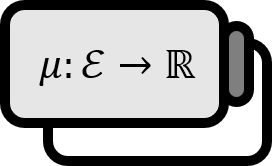Lebesgue Measure
Definition 1
Let us define the function $m : \mathcal{M} \to [0,\infty]$ with respect to $E \in \mathcal{M}$ as follows $m(E) := m^{ \ast } (E)$. $m$ is called the (Lebesgue) measure.
- $\mathcal{M}$ is a sigma-algebra, the set of measurable sets of $X = \mathbb{R}$.
- $m^{\ast}$ is an outer measure.
Description
The outer measure was neatly defined by $m^{ \ast } : \mathscr{P}( \mathbb{R} ) \to [0, \infty]$, but it left something to be desired as a generalization of length. Limiting its domain to the real numbers’ sigma-field completed the ideal ‘generalization of length.’ This can be seen as a step back conditionally to meet the Carathéodory condition.
Of course, this is a special case in $X = \mathbb{R}$ when compared to general measures.
Basic Properties
Assuming $A, B, E \in \mathcal{M}$ and for all $n \in \mathbb{N}$, let’s say $A_{n}, B_{n}, \in \mathcal{M}$. The measure has the following properties:
- [1]: $$A \subset B \implies m(A) \le m(B)$$
- [2]: If $A \subset B$ then, $$m(A) < \infty \implies m(B \setminus A) = m(B) - m(A)$$
- [3]: $$t \in \mathbb{R} \implies m(E) = m(E + t)$$
- [4]: $$m(A \triangle B) = 0 \implies B \in \mathcal{M} \\ m(A) = m(B)$$
- [5]: For all $\varepsilon > 0, A \subset \mathbb{R}$, there exists an open $O$ that satisfies the following. $$ A \subset O \\ m(O) \le m^{ \ast }(A) + \varepsilon $$
- [6]: For all $A \subset \mathbb{R}$, there exists a sequence of open sets $\left\{ O_{n} \right\}$ that satisfies the following. $$ A \subset \bigcap_{n} O_{n} \\ m \left( \bigcap_{n} O_{n} \right) = m^{ \ast }(A) $$
- [7]: $$\displaystyle A_{n} \subset A_{n+1} \implies m \left( \bigcup_{n=1}^{\infty} A_{n} \right) = \lim_{n \to \infty} m (A_{n})$$
- [8]: If $A_{n+1} \subset A_{n}$ then, $$\displaystyle m(A_{1}) < \infty \implies m \left( \bigcap_{n=1}^{\infty} A_{n} \right) = \lim_{n \to \infty} m (A_{n})$$
- [9]: $$\displaystyle m \left( \bigsqcup_{i=1}^{n} A_{i} \right) = \sum_{i = 1}^{n} m (A_{i})$$
- [10]: $m$ is continuous in $\emptyset$.
- [11]: $$B_{n} \to \emptyset \implies m(B_{n}) \to 0$$
- $A \triangle B = ( A \setminus B ) \cup ( B \setminus A )$ is true.
Proof
[1]
Since $m = m^{ \ast } |_{\mathcal{M}}$, it naturally follows from the properties of outer measure.
■
[2]
First, it’s necessary to prove $(B \setminus A) \in \mathcal{M}$. Given $(B \setminus A) = B \cap (\mathbb{R} \setminus A) = B \cap A^{c}$ since $A \in \mathcal{M}$, thus $A^{c} \in \mathcal{M}$. Therefore, $(B \setminus A) \in \mathcal{M}$ and $(B \setminus A ) \cap A = \emptyset$ and $(B \setminus A ) \cup A = B$, thus $m(B \setminus A ) + m(A) = m(B)$ is true. Assuming $m(A) < \infty$, rearranging gives $m(B \setminus A) = m(B) - m(A)$.
■
[3]
Since $m = m^{ \ast } |_{\mathcal{M}}$, it naturally follows from the properties of outer measure.
■
[4]
Since $B = (A \cap B) \cup (B \setminus A) = A \setminus (A \setminus B) \cup (B \setminus A)$, $B \in \mathcal{M}$ is true. Meanwhile, since $m(A \triangle B) = 0$, $m(A \setminus B) = 0$ and $m(B \setminus A) = 0$. Therefore, $$ m(B) = m( B \setminus A) + m(B \cap A) = m( A \setminus B) + m(A \cap B) = m(A) $$
■
[7]
If we assume $B_{n} :=A_{n} \setminus A_{n-1}$, for $i \ne j$, $B_{i} \cap B_{j} = \emptyset$ and $\displaystyle \bigcup_{n=1}^{\infty} A_{n} = \bigsqcup_{n=1}^{\infty} B_{n}$ are true. Therefore, $$ m \left( \bigcup_{n=1}^{\infty} A_{n} \right) = m \left( \bigsqcup_{n=1}^{\infty} B_{n} \right) = \sum_{n=1}^{\infty} m(B_{n}) = \lim_{n \to \infty} \sum_{k=1}^{n} m(B_{k}) = \lim_{n \to \infty} m \left( \bigsqcup_{k=1}^{n} B_{k} \right) = \lim_{n \to \infty} m \left( A_{n} \right) $$
■
[8]
Since $(A_{1} \setminus A_{n} ) \subset (A_{1} \setminus A_{n+1} )$, by [7] $$ m \left( \bigcup_{n=1}^{\infty} ( A_{1} \setminus A_{n} ) \right) = \lim_{ n \to \infty} m (A_{1} \setminus A_{n}) $$ And since $m(A_{n}) < \infty$, by [3] $$ m (A_{1} \setminus A_{n}) = m(A_{1}) - m(A_{n}) $$ Meanwhile, since $\displaystyle \bigcup_{n=1}^{\infty} (A_{1} \setminus A_{n}) = A_{1} \setminus \bigcap_{n=1}^{\infty} A_{n}$ $$ m \left( \bigcup_{n=1}^{\infty} (A_{1} \setminus A_{n}) \right) = m \left( A_{1} \right) - m \left( \bigcap_{n=1}^{\infty} A_{n} \right) $$ Summarizing, $$ m \left( \bigcup_{n=1}^{\infty} (A_{1} \setminus A_{n}) \right) = m(A_{1}) - \lim_{n \to \infty} m(A_{n}) = m \left( A_{1} \right) - m \left( \bigcap_{n=1}^{\infty} A_{n} \right) $$ Therefore, $\displaystyle \lim_{n \to \infty} m(A_{n}) = m \left( \bigcap_{n=1}^{\infty} A_{n} \right)$
■
Generalization
Capinski. (1999). Measure, Integral and Probability: p35. ↩︎
